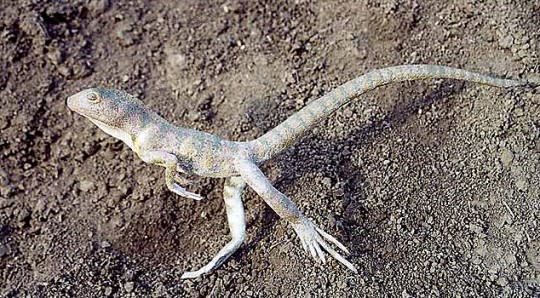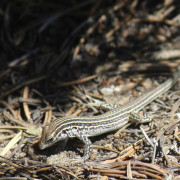- Science News
- Earth science
- Secret to speediness of ancient bipedal reptile has been revealed
Secret to speediness of ancient bipedal reptile has been revealed
By Clarissa Wright, Frontiers science writer

Close-up of a reptile eye, but not the ancient Eudibamus cursoris. Image Aedka Studio/Shutterstock.com
The Early Permian marked a time of major seasonal changes on the planet, as reptiles rapidly diversified. A key innovation is seen in bolosaurids with the ability to run at high speeds on two legs.
Scientists from California State University and Carnegie Museum of Natural History in the US and University of Toronto Mississauga, Canada, collaborated in a study recently published to Frontiers presenting the first comprehensive description of the earliest known bipedal reptile from the Early Permian – a type of bolosaurid called Eudibamus cursoris. For the first time, its unique style of locomotion that achieved high running speeds on two legs has been revealed.
The Permian period (between 298.9m and 252.2m years ago) was the last period of the Paleozoic Era. The Earth was warming out of an ice age, while weather intensified. Remnants of carboniferous rainforests disappeared, replaced by open desert. Facing these environmental changes, reptiles rapidly diversified and showed remarkable innovations during the Permian.
Bolosaurids are the oldest family belonging to the ancient group of extinct reptiles known as Parareptilla (or parareptiles), and are considered a ‘sister taxon’ to modern-day reptiles (of the Eureptilia group). From the Earliest Permian to the latest Roadian stage (268.8m years ago), bolosaurids lived in North America, China, France, Germany, and Russia.
Having faced many predators, bolosaurids were a rare group and eventually died out without any known descendants. They were considered unusual for the period, as they were the oldest known tetrapods (four-legged animals) to have been bipedal – able to move on two legs.
Download original article (pdf)
The first bipedal reptile
The bolosaurid Eudibamus was the very first bipedal reptile to appear in the fossil record. Information about Eudibamus derives from a near-complete skeleton specimen of Eudibamus cursoris, the holotype (type species), that was found at Bromacker Quarry in the middle of the Thuringian Forest in Germany.
While a brief description of the specimen was published in 2000, it was not until recently, that scientists from California State University in the US, and University of Toronto Mississauga in Canada, published the first comprehensive description in Frontiers in Ecology and Evolution. In addition to the holotype, they discovered a second, more mature specimen of the species at the same locality which was very well preserved, showing a small part of the vertebral column associated with the pelvis and right hindlimb – revealing a unique style of locomotion.
In their study, the researchers presented a clearer understanding of the type species and its agility. The team found that Eudibamus cursoris was the first reptile able to move on two or four legs using its toes, at a parasagittal stride where the forelimb is brought under the body. This quadrupedal and bipedal style of locomotion was the secret to its speed, that could have given it the agility to escape the numerous predators of the Permian.

Model of Eudibamus cursoris made by Peter Mildner of the Museum der Natur, Gotha photographed in 2006. Image: Peter Mildner/Carnegie Museum of Natural History
The secret to speedy movement
The authors wrote: “Eudibamus cursoris is truly a unique reptile for its times. Not only is it among the few oldest known bipedal reptiles, it is also the oldest known late Paleozoic reptile capable of achieving relatively high running speeds during quadrupedal and bipedal locomotion. This was accomplished by uniquely employing a parasagittal stride and digitigrade posture with the limbs positioned in a near vertical stance beneath the trunk and swung fore and aft in a pendulum-like style.”
A parasagittal posture creates a more erect orientation, as the limbs are held relatively vertical. Most mammals have this posture, and we can easily observe it in birds. We also see clear examples of the digitigrade posture — the animal’s ability to walk on its toes and not touch the ground with its heels — in dogs, cats and rodents.
These observations support the previous interpretation that Eudibamus cursoris ran at relatively high speeds, whether on two limbs or four, as the limbs were held in a near vertical posture and swung back and forth. As herbivores, this would have been an effective way of escaping predators.
This unique style of locomotion, which the authors described as “a surprising combination of features and locomotory abilities”, contrasts with the majority of other herbivores during not only the Permian, but the Paleozoic era, who were mostly slow, short-limbed and relatively large in size.
The study also suggests that other reptiles around the same age may not have been restricted to a sprawling style of locomotion that we see with many modern-day reptiles, but like Eudibamus cursoris, could have escaped predators while running on two legs.
REPUBLISHING GUIDELINES: Open access and sharing research is part of Frontiers’ mission. Unless otherwise noted, you can republish articles posted in the Frontiers news blog — as long as you include a link back to the original research. Selling the articles is not allowed.







